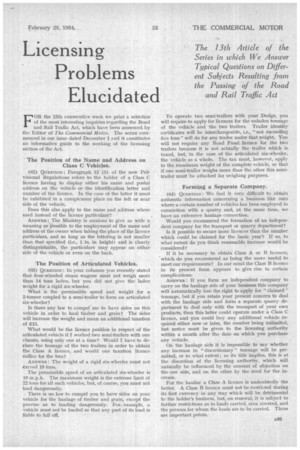Licensing Problems Elucidated
Page 49

If you've noticed an error in this article please click here to report it so we can fix it.
The 13th Article of the Series in which We Answer Typical Questions on Different Subjects Resulting from the Passing of the Road and Rail Traffic Act
FOR the 13th consecutive week we print a selection of the most interesting inquiries regarding the Road and Rail Traffic Act, which have been answered. by the Editor of The Commercial Motor. The series commenced in our issue dated December 1 and it constitutes an informative guide to the working of the licensing section of the Act.
' The Position of the Name and Address on Class C Vehicles.
(62) QUEsTION : Paragraph 12 (3) of the new Provisional Regulations refers to the holder of a Class C licence having to display either his name and postal address on the vehicle or the identification letter and number of the licence. In the case of the latter it must be exhibited in a conspicuous place on the left or near side of the vehicle.
Does this also apply to the name and address where used instead of the licence particulars?
ANSWER: The Ministry is anxious to give as wide a meaning as possible to the employment of the name and address of the owner when taking the place of the licence particulars, and so long as the lettering is not smaller than that specified (i.e., 1 hi. in height) and is clearly distinguishable, the particulars may appear on either side of the vehicle or even on the back.
The Position of Articulated Vehicles.
(63) QUESTION In your columns you recently stated that four-wheeled steam wagons must not weigh more than 14 tons laden, but you did not give the laden weight for a rigid six-wheeler.
What is the permissible speed and weight for a 2-tormer coupled to a semi-trailer to form an articulated six-wheeler?
Is there any law to compel me to have sides on this vehicle in order to haul timber and grain? The sides will increase the weight and mean an additional taxation of £15.
What would be the licence position in respect of the articulated vehicle if I worked two semi-trailers with one chassis, using only one at a time? Would I have to declare the tonnage of the two trailers in order to obtain the Class A licence, and would one taxation licence suffice for the two?
ANSWER: The weight of a rigid six-wheeler must not exceed 19 tons.
The permissible speed of an articulated six-wheeler is 16 m.p.h. The maximum weight is the extreme limit of 22 tons for all such vehicles, but, of course, you must not load dangerously.
There is no law to compel you to have sides on your vehicle for the haulage of timber and grain, except the proviso as to loading dangerously. For. example, a vehicle must not be loaded so that any part of its load is liable to fall off. To operate two semi-trailers with your Dodge, you will require to apply for licences for the unladen tonnage of the vehicle and the two trailers. Trailer identity certificates will be interchangeable, i.e., "not exceeding five tons" will do for any trailer under that weight. You will not require any Road Fund licence for the two trailers because it is not actually the trailer which is taxed, but, in the case of the articulated six-wheeler, the vehicle as a whole. The tax must, however, apply to the maximum weight of the complete vehicle, so that if one semi-trailer weighs more than the other this semitrailer must be attached for weighing purposes.
Forming a Separate Company.
(64) QuEsTioN : We find it very difficult to obtain authentic information concerning a business like ours where a certain number of vehicles has been employed in connection with a quarry and, at the same time, we have an extensive haulage connection.
Would you recommend the formation of an independent company for the transport or quarry department?
Is it possible to secure more licences than the number which could be claimed for the basic year? If so, to what extent do you think reasonable increase would be considered?
If it be necessary to obtain Class A or B licences, which do you recommend as being the more useful to meet our requirements? In our mind the Class B licence in its present form appears to give rise to certain complications.
ANSWER: If you form an independent company to carry on the haulage side of your business this company will automatically lose the right to apply for "claimed " tonnage, but if you retain your present concern to deal with the haulage side and form a separate quarry department to deal only with the transport of your own products, then this latter could operate under a Class C licence, and you could buy any additional vehicle required either now or later, the number being unlimited, but notice must be given to the licensing authority within a month after the date on which you purchase any vehicle.
On the haulage side it is impossible to say whether any increase in " discretionary " tonnage will be permitted, or to what extent; as its title implies, this is at the discretion of the licensing authority, which will naturally be influenced by the amount of objection on the one side, and on the other by the need for the increase.
For the haulier a Class A licence is undoubtedly the better. A Class B licence must not be restricted during its first currency in any way which will be detrimental to the holder's business, but, on renewal, it is subject to further restrictions as to loads carried, area covered, and the persons for whom the loads are to be carried. These are important points.




























































































